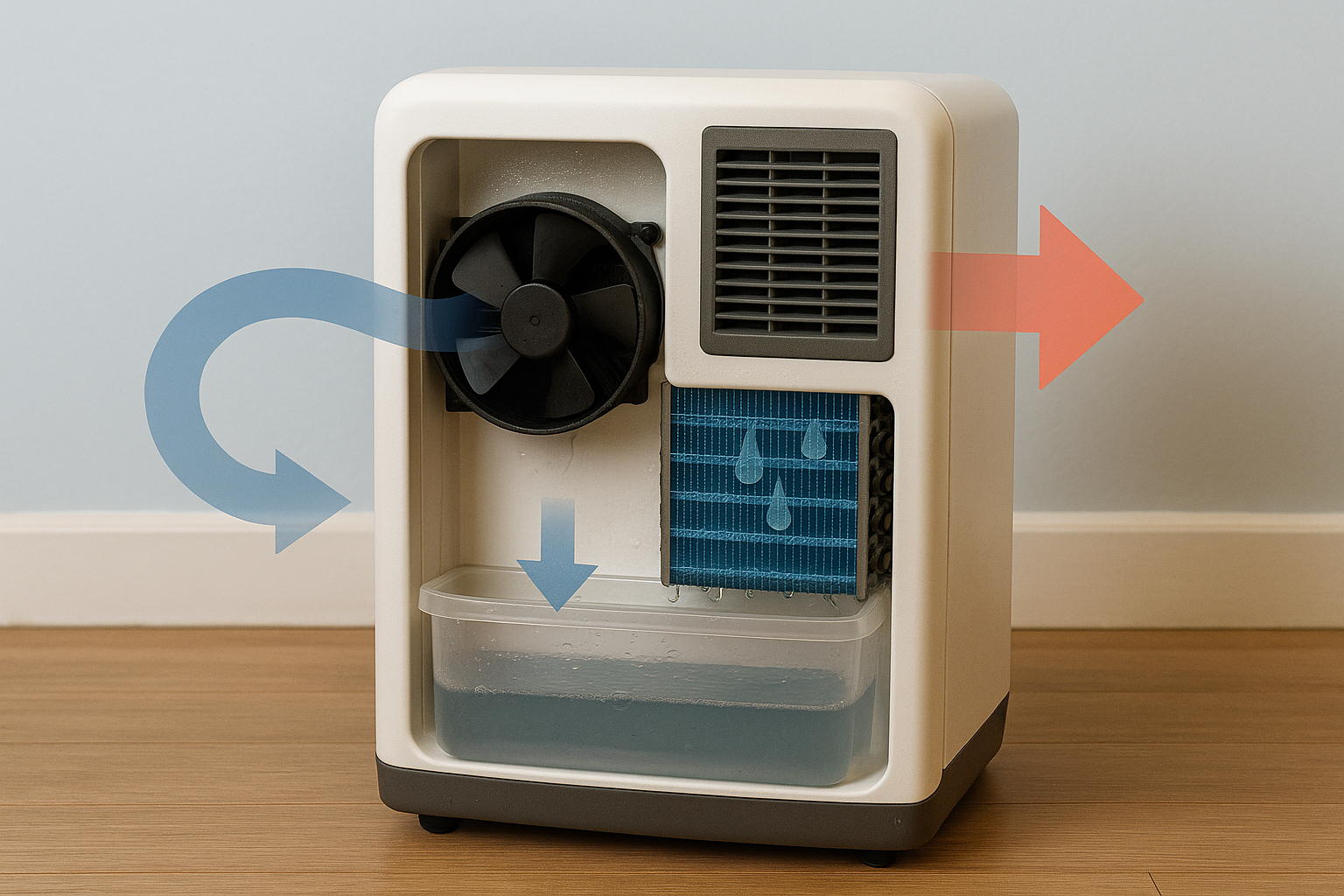If your home ever feels damp, smells musty, or has condensation on the windows, excess moisture might be the problem. Left unchecked, it can lead to mould, peeling paint, and even trigger allergies and other health and respiratory issues.
A dehumidifier can help create a healthier and more comfortable indoor environment by removing excess moisture from the air. But how does it actually work? In this guide, we’ll break down exactly how dehumidifiers work, step by step.
How Does a Dehumidifier Work: Step by Step
Step 1: Air Intake
![[MK] Draft: How Does a Dehumidifier Work](https://www.market.com/wp-content/uploads/2025/08/-mk-draft-how-does-a-dehumidifier-work-1.png)
Once turned on, the fan inside the dehumidifier pulls humid air from the room into the dehumidifier through a grille. Often, the air also passes through a filter that removes dust, microparticles and debris.
Step 2: Cooling the Air
![[MK] Draft: How Does a Dehumidifier Work](https://www.market.com/wp-content/uploads/2025/08/-mk-draft-how-does-a-dehumidifier-work-2.png)
The air then passes over cold metal coils (evaporator coils). As the air cools, the moisture in it condenses into water droplets (like condensation on a cold drink).
Step 3: Collecting the Water
![[MK] Draft: How Does a Dehumidifier Work](https://www.market.com/wp-content/uploads/2025/08/-mk-draft-how-does-a-dehumidifier-work-3.png)
The condensed water drips down and collects in the water tank. Once full, the water tank will need emptying. Some models have an indicator to let you know when to empty, while some include a drainage hose for non-stop operation.
Step 4: Reheating and Releasing the Air
![[MK] Draft: How Does a Dehumidifier Work](https://www.market.com/wp-content/uploads/2025/08/-mk-draft-how-does-a-dehumidifier-work-4.png)
After the moisture is removed from the humid air, it passes over a warm coil or motor and is slightly reheated. The dry air is recycled and blown back into the room.
Step 5: Monitoring Humidity (Optional with Advanced Models)
Some dehumidifiers use a built-in humidistat to measure room humidity and adjust the levels automatically. Others simply run until full and are manually turned off.
Common Features in Modern Dehumidifiers
While all dehumidifiers are designed to remove excess moisture from the air, many modern models come with added features that improve efficiency, convenience, and overall usability. Below are some of the most common options, and whether they’re worth having.
Built-in Humidistat
What it does:
Monitors the humidity level in the room and automatically turns the unit on or off to maintain your desired setting.
Is it necessary?
Very useful for energy savings and consistent comfort. It prevents over-drying and keeps humidity levels stable without manual adjustments.
Auto Shut-off
What it does:
Automatically turns the unit off when the water tank is full or when your target humidity is reached.
Is it necessary?
It’s essential for safety and convenience, especially if you’re not using a continuous drainage hose. It prevents spills and protects the motor from running unnecessarily.
Continuous Drainage Option
What it does:
Lets you attach a hose so the unit can drain collected water directly into a sink or floor drain, allowing it to operate non-stop.
Is it necessary?
Very helpful if you want to run the dehumidifier continuously without having to empty the tank regularly, ideal for basements or high-humidity spaces.
Defrost Function
What it does:
Prevents ice buildup on the internal coils, allowing the dehumidifier to work properly in colder environments.
Is it necessary?
Important for garages, basements, or unheated rooms where temperatures drop. Not essential for most standard home setups.
Timer and Scheduling
What it does:
Allows you to program the dehumidifier to start or stop at specific times.
Is it necessary?
A useful bonus for energy efficiency and convenience, but not a dealbreaker if you plan to use it manually.
Air Purification Features (Optional Filters)
What it does:
Some models include HEPA or carbon filters to remove dust, allergens, and odours from the air.
Is it necessary?
Only if you’re looking for dual-purpose air improvement, suffer from severe allergies or get a lot of dust in your home. Not needed if your main concern is just moisture control.



